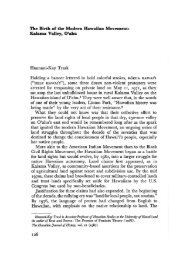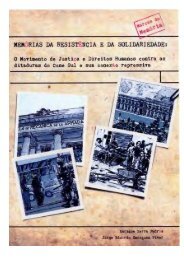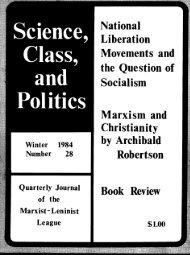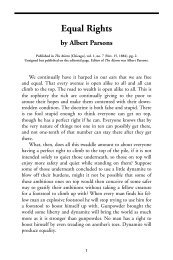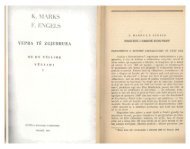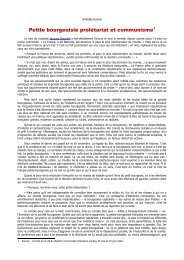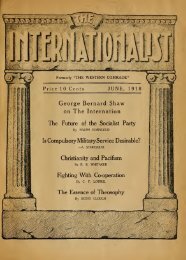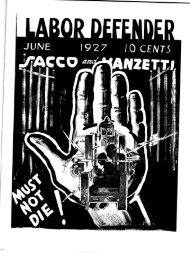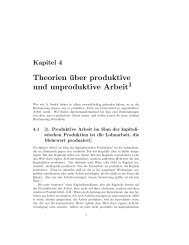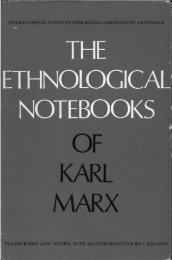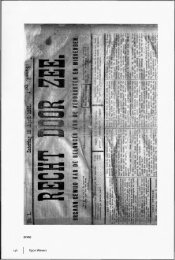The Stalin school of falsification - Marxists Internet Archive
The Stalin school of falsification - Marxists Internet Archive
The Stalin school of falsification - Marxists Internet Archive
You also want an ePaper? Increase the reach of your titles
YUMPU automatically turns print PDFs into web optimized ePapers that Google loves.
<strong>Stalin</strong> School <strong>of</strong> Falsfification - Chapter 6<br />
inevitable conclusion. Thus, the permanent revolution in Russia is passing into the European proletarian<br />
revolution." (From the Collapse <strong>of</strong> Czarism to the Fall <strong>of</strong> the Bourgeoisie, p. 78. Our emphasis.)<br />
<strong>The</strong> brochure ends with the following words:<br />
"Into the powder magazine <strong>of</strong> old blood-stained Europe was thrown the torch <strong>of</strong> the Russian socialist<br />
revolution. It has not died. It lives. It is spreading. And it will inevitably merge with the great triumphant<br />
uprising <strong>of</strong> the world proletariat." (Ibid., p. 144.)<br />
How infinitely removed was Bukharin <strong>of</strong> that time from the theory <strong>of</strong> socialism in one country!<br />
It is common knowledge that Bukharin was the chief and indeed the sole theoretician <strong>of</strong> the entire<br />
campaign against "Trotskyism," summed up in the struggle against the theory <strong>of</strong> the permanent<br />
revolution. But at an earlier period when the lava <strong>of</strong> the revolutionary upheaval had not yet cooled,<br />
Bukharin, as we see, was unable to provide a characterization for revolution different from the one<br />
against which, a few years later, he was to wage a ruthless struggle.<br />
Bukharin's brochure was issued by the <strong>of</strong>ficial party publishing house, Priboy, under the supervision <strong>of</strong><br />
the Central Committee. Not only did no one declare that pamphlet heretical but, on the contrary,<br />
everyone accepted it as the <strong>of</strong>ficial and unchallenged expression <strong>of</strong> the views <strong>of</strong> the Central Committee<br />
<strong>of</strong> the party. This brochure went through several editions in the course <strong>of</strong> the next few years. Together<br />
with another brochure devoted to the February Revolution it appeared in translations into German,<br />
French, English and other languages, under the general title, From the Collapse <strong>of</strong> Czarism to the Fall <strong>of</strong><br />
the Bourgeoisie.<br />
In 1923, the brochure was published — apparently for the last time — by the Kharkov party publishing<br />
house, Proletari. <strong>The</strong> preface to this edition expressed the conviction that this little book "will prove <strong>of</strong><br />
great interest" not only to new members <strong>of</strong> the party, the youth and so forth, but also "to the Bolshevik<br />
Old Guard <strong>of</strong> the underground period <strong>of</strong> our party."<br />
That Bukharin is not very staunch in his views is sufficiently well known. But it is not a question <strong>of</strong><br />
Bukharin himself. If we are to believe the legend created for the first time in the autumn <strong>of</strong> 1924, that<br />
there was an impassable abyss between Lenin's understanding <strong>of</strong> revolution and Trotsky's theory <strong>of</strong> the<br />
permanent revolution, and that the old generation <strong>of</strong> the party was brought up on the understanding <strong>of</strong> the<br />
irreconcilability <strong>of</strong> these two theories, then it is incomprehensible why Bukharin, at the beginning <strong>of</strong><br />
1918, could preach this theory with impunity, calling it by its name — the theory <strong>of</strong> the permanent<br />
revolution. How did it happen that not a single person — literally nobody in the entire party — took issue<br />
with Bukharin? How and why did the <strong>of</strong>ficial publishing house <strong>of</strong> the Central Committee publish this<br />
brochure? How and why did Lenin happen to keep silent? How and why did the Comintern publish in<br />
several foreign languages this brochure <strong>of</strong> Bukharin in defense <strong>of</strong> the permanent revolution? How and<br />
why did Bukharin's brochure retain its status as a party textbook up to the very death <strong>of</strong> Lenin? How and<br />
why was Bukharin's brochure republished as late as 1928 and warmly recommended both to the party<br />
youth and to the Bolshevik Old Guard in Kharkov — the future center <strong>of</strong> <strong>Stalin</strong>ist zealots?<br />
This brochure <strong>of</strong> Bukharin's differs from his later writings and from the entire latter-day <strong>Stalin</strong>ist<br />
historiography, not only in its characterization <strong>of</strong> the revolution, but also in its manner <strong>of</strong> portraying the<br />
participants <strong>of</strong> the revolution. For example, we find the following on page 131 <strong>of</strong> the Kharkov edition:<br />
"<strong>The</strong> focal point <strong>of</strong> political life became . . . not the pathetic Soviet <strong>of</strong> the Republic, but the impending<br />
http://www.marxists.org/archive/trotsky/works/1937-st2/sf06.htm (18 <strong>of</strong> 24) [06/06/2002 15:06:34]



